Introducing all very interesting books for practicing your English language skills, reading and vocabulary development, listening and notetaking.
These books will help students attending classes at CGI which lectures and teaching medium is English.Tweet
Patricia Ackert and Linda Lee
|
Facts & Figures, Fourth Edition
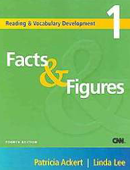
Call no. PE1128 L478F 2005 Learners increase their active vocabulary from 300 to 800 words.
|
Thoughts & Notions, Second Edition
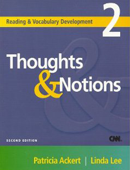
Call no. PE1128 A182T 2005 Learners increase their active vocabulary from 800 to 2,000 words.
|
Cause & Effect, Fourth Edition
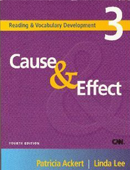
Call no. PE1128 A182E 2005 Learners increase their active vocabulary from 2,000 to 3,000 words.
|
Concepts & Comments, Third Edition
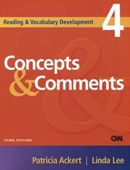
Call no. PE1128 A182C 2006 Learners increase their active vocabulary from 3,000 to 4,000 words.
|
| Description & Features
Through wonderful readings and carefully designed activities, this best-selling series helps students develop reading skills and systematically increase their active vocabulary. Learners develop useful and relevant vocabulary while exploring and expanding critical thinking skills. Five thematic reading selections per unit recycle vocabulary, sentence structure, and content knowledge.
Carefully designed pre-reading work and post-reading comprehension activities build students’ reading and critical thinking skills.
A variety of exercises and games as well as dictionary activities and collocations recycle key vocabulary found throughout the readings. (Publisher’s note)
(Recommended by Mr.Maurice M. Broughton) |
Patricia A. Dunkel, Phyllis L. Lim
| Description & Features
The third edition of this groundbreaking book includes videotaped lectures in DVD or VHS format. Now teachers can use the audio program (available on both tapes and CD) with the support of video simulation of an academic lecture experience. Many new and updated lectures with high-interest topics are included. (Publisher’s note) (Recommended by Mr.Maurice M. Broughton) |
|
Intermediate Listening Comprehension
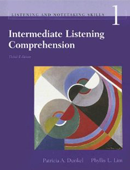 Call no. PE1128 D919I 2006 INTERMEDIATE LISTENING COMPREHENSION is designed to familiarize students with the major rhetorical patterns of formal, spoken English.
Focuses on major rhetorical patterns (chronological, compare/contrast, process/definition/classification, and causal analysis).
Lectures from across the curriculum (history, science, anthropology, American studies, language arts).
Carefully sequenced progression of activities.
Spiraled rhetorical patterns, vocabulary, and structures.
Integrated speaking practice.
Pre- and post-listening activities.
|
Noteworthy – Listening & Notetaking Skills
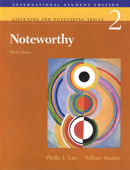 Call no. PE1128 L732N 2005 NOTEWORTHY develops students’ listening and notetaking skills, provides insights into U.S. life and culture, and builds cross-disciplinary vocabulary.
Notetaking techniques for academically-bound students.
Pre- and post-listening activities.
Content-based topics that focus on the United States.
Pair/group work that builds oral competence.
Sub-technical vocabulary building.
|
Advanced Listening Comprehension
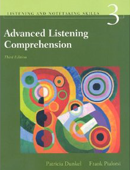 Call no. PE1128 D919A 2005 Lectures and readings on topics of universal interest provide stimulating content-based material for developing comprehension, notetaking, and academic study skills. Compelling cross-curricular lectures for stimulating, up-to-date content.
Pre- and post-listening activities.
Spiraled vocabulary, structures, and rhetorical patterns.
Content-based units and lectures.
Guided notetaking practice.
|
Steve Jones, Suzanne Kalbach, Marianne Brems
|
Catalyst 1 – Writing from Reading
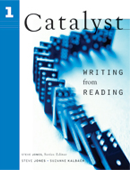
Call no. PE1427 J79C 2008 |
Catalyst 2 – Writing from Reading
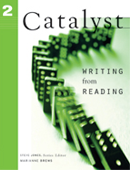
Call no. PE1417 B836C 2008 |
| Description & Features
Connecting students’ everyday experiences to different academic disciplines, Catalyst uses a variety of readings as a springboard for writing. Compelling readings on topics such as personalities, the meaning of art, the history of architecture, and the role of sports engage students and act as a catalyst for writing.
A balanced approach to writing guides students through the writing process and teaches them the mechanics of good writing.
Grammar explanations and exercises woven throughout each chapter help students express their ideas more clearly.
Vocabulary exercises introduce high-frequency words students need in their daily lives plus words from the Academic Word List students will encounter in college.
A variety of discussion questions encourage students to summarize readings and draw conclusions – essential skills for academic success. (Publisher’s note)
(Recommended by Mr.Maurice M. Broughton) |
Phil Biggerton
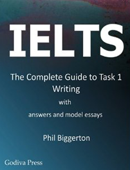
|
Call no. PE1128 B529I 2010
Description : The Complete Guide to Task 1 Writing has been written for both beginners and more advanced students of IELTS and offers an ideal way to prepare more thoroughly for the IELTS test.
The student is taken step by step in simple, plain English through all the various stages of writing a 150-word Task 1 essay. The mistakes commonly made when analysing a diagram are highlighted and, more effective, easy to remember tips are provided to help ensure a higher grade in the exam. The Complete Guide to Task 1 Writing provides over 70 exercises (including 33 complete tests) to help practice exam skills. Diagrams include: Bar Charts, Line Charts, Pie Charts, TablesProcesses, Cycles, Flow Charts, Objects, Maps
Model answers are provided for each practice test and help explain more clearly what the IELTS examiner is looking for when he marks the Task 1 essay.
(Recommended by Mr.Maurice M. Broughton) |
